Kuppan T. Heat Exchanger Design Handbook
Подождите немного. Документ загружается.

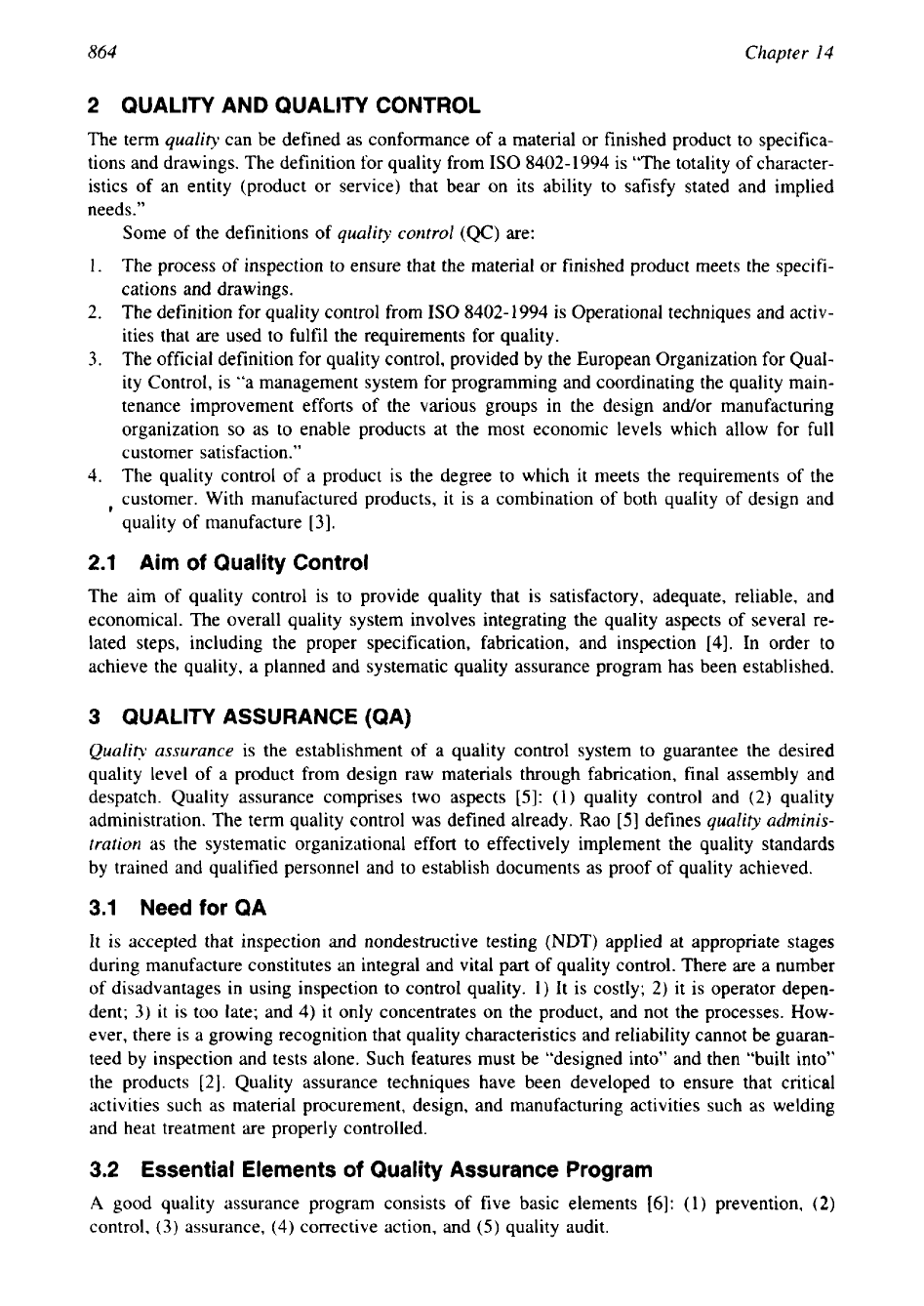
864
Chapter
I4
2
QUALITY AND QUALITY CONTROL
The term
quality
can be defined as conformance of a material or finished product to specifica-
tions and drawings. The definition for quality from
IS0
8402-1994 is “The totality of character-
istics of an entity (product or service) that bear on its ability to safisfy stated and implied
needs.”
Some of the definitions of
quality control
(QC) are:
1.
The process of inspection to ensure that the material or finished product meets the specifi-
cations and drawings.
2.
The definition for quality control from
IS0
8402-1994
is Operational techniques and activ-
ities that are used to fulfil the requirements for quality.
3.
The official definition for quality control, provided by the European Organization for Qual-
ity Control, is “a management system for programming and coordinating the quality main-
tenance improvement efforts of the various groups in the design andor manufacturing
organization
so
as to enable products at the most economic levels which allow for
full
customer satisfaction.”
4.
The quality control of a product is the degree to which it meets the requirements of the
customer. With manufactured products,
it
is a combination of both quality of design and
quality of manufacture [3].
2.1
Aim
of
Quality Control
The aim of quality control is to provide quality that is satisfactory, adequate, reliable, and
economical. The overall quality system involves integrating the quality aspects of several re-
lated steps, including the proper specification, fabrication, and inspection [4]. In order to
achieve the quality, a planned and systematic quality assurance program has been established.
3
QUALITY ASSURANCE (QA)
Quality assurance
is the establishment of a quality control system to guarantee the desired
quality level of a product from design raw materials through fabrication, final assembly and
despatch. Quality assurance comprises two aspects
[5]:
(1) quality control and
(2)
quality
administration. The term quality control was defined already. Rao
[5]
defines
quality adminis-
tration
as the systematic organizational effort to effectively implement the quality standards
by trained and qualified personnel and to establish documents as proof of quality achieved.
3.1
Need for QA
It is accepted that inspection and nondestructive testing (NDT) applied at appropriate stages
during manufacture constitutes an integral and vital part of quality control. There are a number
of disadvantages in using inspection to control quality.
I)
It is costly;
2)
it is operator depen-
dent;
3)
it
is too late; and
4)
it only concentrates on the product, and not the processes.
How-
ever, there is a growing recognition that quality characteristics and reliability cannot be guaran-
teed by inspection and tests alone. Such features must be “designed into” and then “built into”
the products
[2].
Quality assurance techniques have been developed to ensure that critical
activities such as material procurement, design, and manufacturing activities such as welding
and heat treatment are properly controlled.
3.2
Essential Elements
of
Quality Assurance Program
A
good quality assurance program consists of five basic elements
[6]:
(1) prevention,
(2)
control,
(3)
assurance, (4) corrective action, and
(5)
quality audit.
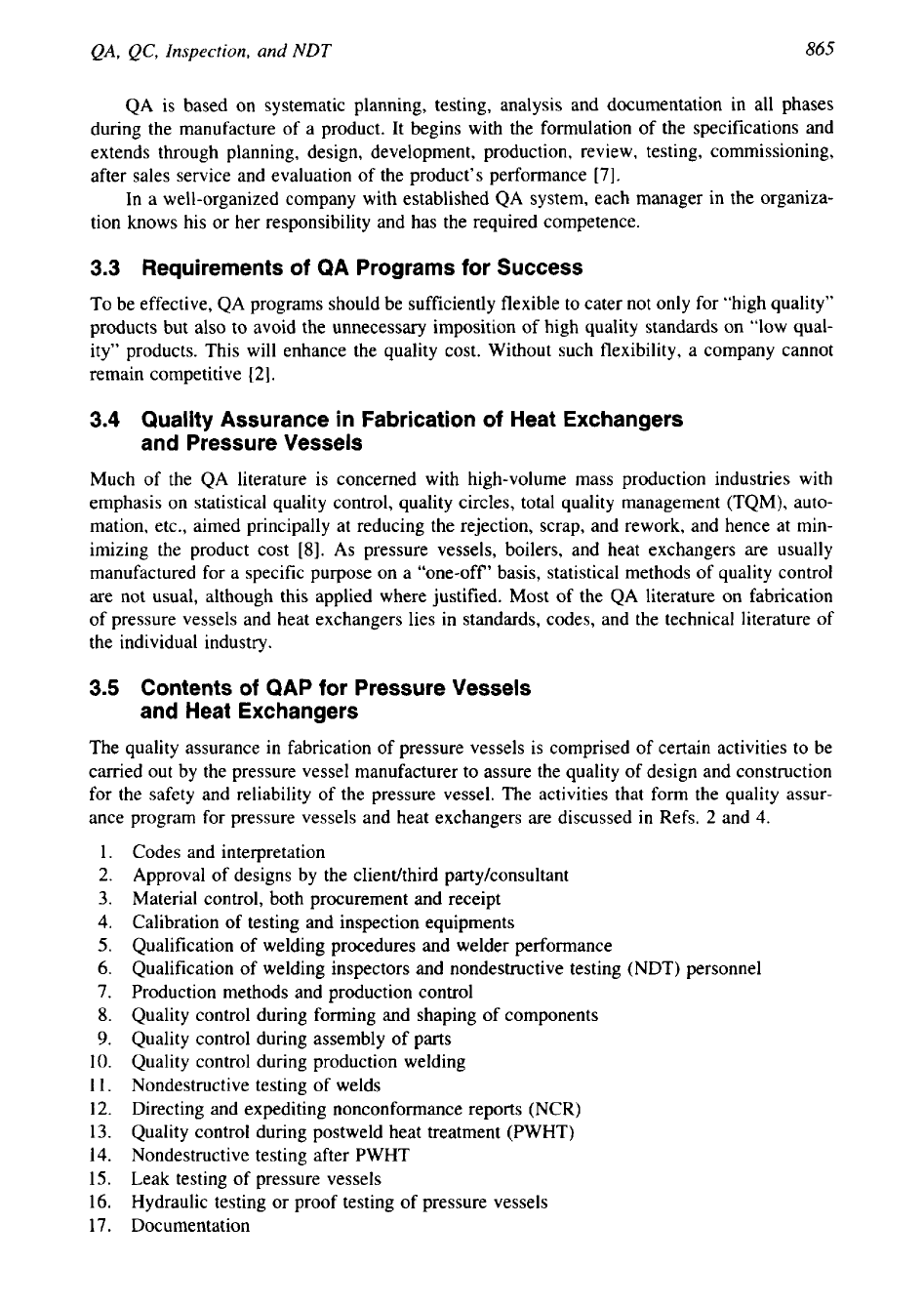
QA,
QC,
Inspection,
and
NDT
865
QA is based on systematic planning, testing, analysis and documentation in all phases
during the manufacture of a product. It begins with the formulation of the specifications and
extends through planning, design, development, production, review, testing, commissioning,
after sales service and evaluation of the product’s performance [7].
In a well-organized company with established QA system, each manager in the organiza-
tion knows his or her responsibility and has the required competence.
3.3
Requirements of
QA
Programs for Success
To be effective, QA programs should be sufficiently flexible to cater not only for “high quality”
products but also
to
avoid the unnecessary imposition
of
high quality standards on “low qual-
ity” products. This will enhance the quality cost. Without such flexibility, a company cannot
remain competitive
[2].
3.4
Quality Assurance in Fabrication
of
Heat Exchangers
and Pressure Vessels
Much of the QA literature is concerned with high-volume mass production industries with
emphasis on statistical quality control, quality circles, total quality management (TQM), auto-
mation, etc., aimed principally at reducing the rejection, scrap, and rework, and hence at min-
imizing the product cost [8]. As pressure vessels, boilers, and heat exchangers are usually
manufactured for a specific purpose on a “one-off’ basis, statistical methods of quality control
are not usual, although this applied where justified. Most of the QA literature on fabrication
of pressure vessels and heat exchangers lies in standards, codes, and the technical literature of
the individual industry.
3.5
Contents
of
QAP for Pressure Vessels
and Heat Exchangers
The quality assurance in fabrication of pressure vessels is comprised of certain activities to be
carried out by the pressure vessel manufacturer to assure the quality
of
design and construction
for the safety and reliability of the pressure vessel. The activities that form the quality assur-
ance program for pressure vessels and heat exchangers are discussed in Refs.
2
and 4.
1.
Codes and interpretation
2.
Approval of designs by the clienuthird partykonsultant
3.
Material control, both procurement and receipt
4.
Calibration
of
testing and inspection equipments
5.
Qualification of welding procedures and welder performance
6.
Qualification
of
welding inspectors and nondestructive testing (NDT) personnel
7.
Production methods and production control
8.
Quality control during forming and shaping
of
components
9.
Quality control during assembly of
parts
10.
Quality control during production welding
11.
Nondestructive testing of welds
12.
Directing and expediting nonconformance reports (NCR)
13.
Quality control during postweld heat treatment (PWHT)
14.
Nondestructive testing after PWHT
15.
Leak testing of pressure vessels
16.
Hydraulic testing or proof testing of pressure vessels
17.
Documentation
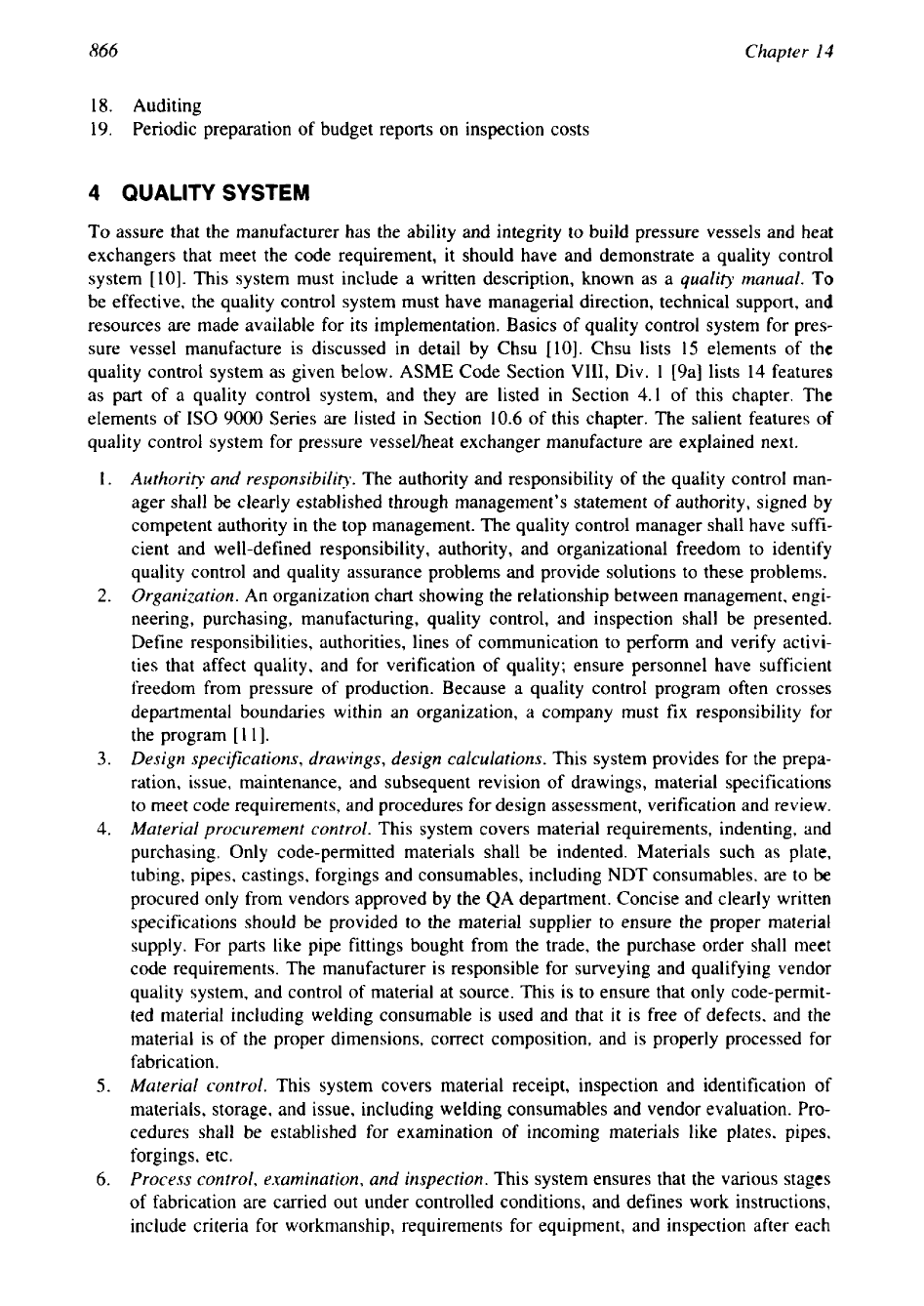
866
Chapter
14
18. Auditing
19.
Periodic preparation of budget reports on inspection costs
4
QUALITY
SYSTEM
To
assure that the manufacturer has the ability and integrity to build pressure vessels and heat
exchangers that meet the code requirement, it should have and demonstrate a quality control
system
[
101. This system must include a written description, known as a
quality manual.
To
be effective, the quality control system must have managerial direction, technical support, and
resources are made available for its implementation. Basics of quality control system for pres-
sure vessel manufacture is discussed in detail by Chsu [lO]. Chsu lists 15 elements of the
quality control system as given below. ASME Code Section
VIII,
Div.
1
[9a] lists 14 features
as part of a quality control system, and they are listed in Section 4.1 of this chapter. The
elements of
IS0
9000
Series are listed in Section 10.6 of this chapter. The salient features
of
quality control system for pressure vesselheat exchanger manufacture are explained next.
1.
Authorio and responsibility.
The authority and responsibility of the quality control man-
ager shall
be
clearly established through management’s statement of authority, signed by
competent authority in the top management. The quality control manager shall have suffi-
cient and well-defined responsibility, authority, and organizational freedom to identify
quality control and quality assurance problems and provide solutions to these problems.
2. Organization.
An organization chart showing the relationship between management, engi-
neering, purchasing, manufacturing, quality control, and inspection shall be presented.
Define responsibilities, authorities, lines of communication to perform and verify activi-
ties that affect quality, and for verification of quality; ensure personnel have sufficient
freedom from pressure of production. Because a quality control program often crosses
departmental boundaries within an organization, a company must fix responsibility for
the program
[
1 I].
3.
Design specifications, drawings, design calculations.
This system provides for the prepa-
ration, issue, maintenance, and subsequent revision of drawings, material specifications
to meet code requirements, and procedures for design assessment, verification and review.
4.
Material procurement control.
This system covers material requirements, indenting, and
purchasing. Only code-permitted materials shall be indented. Materials such as plate,
tubing, pipes, castings, forgings and consumables, including NDT consumables, are to
be
procured only from vendors approved by the
QA
department. Concise and clearly written
specifications should be provided to the material supplier to ensure the proper material
supply. For parts like pipe fittings bought from the trade, the purchase order shall meet
code requirements. The manufacturer is responsible for surveying and qualifying vendor
quality system, and control of material at source. This is to ensure that only code-permit-
ted material including welding consumable is used and that it is free of defects, and the
material is of the proper dimensions, correct composition, and is properly processed for
fabrication.
5.
Material control.
This system covers material receipt, inspection and identification of
materials, storage, and issue, including welding consumables and vendor evaluation. Pro-
cedures shall be established for examination of incoming materials like plates. pipes,
forgings, etc.
6.
Process control, examination, and inspection.
This system ensures that the various stages
of fabrication are carried out under controlled conditions, and defines work instructions,
include criteria for workmanship, requirements for equipment, and inspection after each
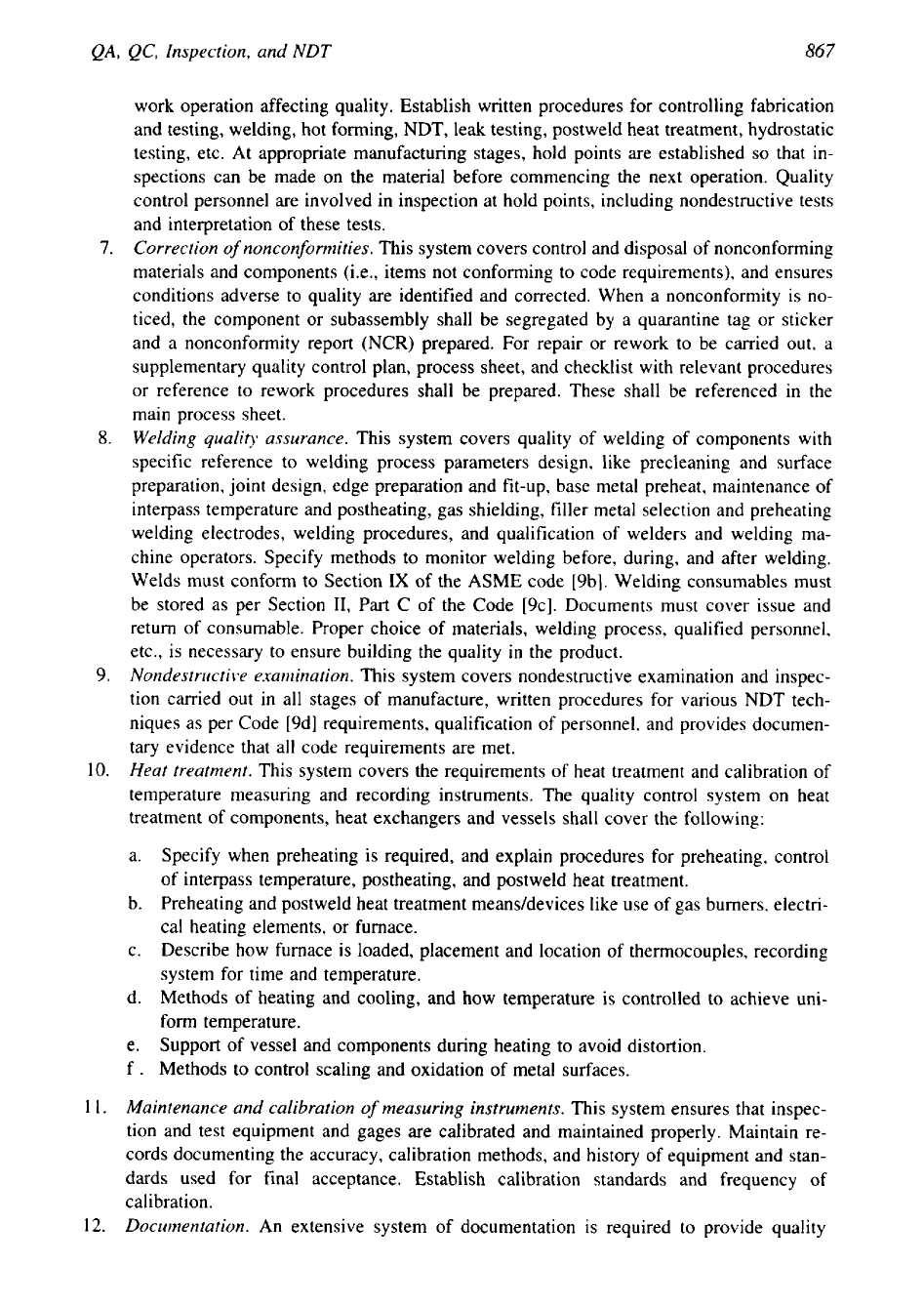
867
QA, QC, Inspection, and
NDT
work operation affecting quality. Establish written procedures for controlling fabrication
and testing, welding, hot forming, NDT, leak testing, postweld heat treatment, hydrostatic
testing, etc. At appropriate manufacturing stages, hold points are established
so
that in-
spections can be made on the material before commencing the next operation. Quality
control personnel are involved in inspection at hold points, including nondestructive tests
and interpretation of these tests.
7.
Correction of nonconformities.
This system covers control and disposal of nonconforming
materials and components (Le., items not conforming to code requirements), and ensures
conditions adverse to quality are identified and corrected. When a nonconformity is no-
ticed, the component or subassembly shall be segregated by a quarantine tag or sticker
and a nonconformity report (NCR) prepared. For repair or rework to be carried out, a
supplementary quality control plan, process sheet, and checklist with relevant procedures
or reference to rework procedures shall be prepared. These shall be referenced
in
the
main process sheet.
8.
Welding quality assurance.
This system covers quality of welding of components with
specific reference to welding process parameters design, like precleaning and surface
preparation, joint design, edge preparation and fit-up, base metal preheat, maintenance of
interpass temperature and postheating, gas shielding, filler metal selection and preheating
welding electrodes, welding procedures, and qualification of welders and welding ma-
chine operators. Specify methods to monitor welding before, during, and after welding.
Welds must conform to Section
IX
of the ASME code [9b]. Welding consumables must
be stored as per Section
11,
Part C of the Code [Sc]. Documents must cover issue and
return of consumable. Proper choice of materials, welding process, qualified personnel,
etc., is necessary to ensure building the quality in the product.
9.
Nondestriictiite examination.
This system covers nondestructive examination and inspec-
tion carried out in all stages of manufacture, written procedures for various NDT tech-
niques as per Code [9d] requirements, qualification of personnel, and provides documen-
tary evidence that all code requirements are met.
10.
Heat treatment.
This system covers the requirements of heat treatment and calibration of
temperature measuring and recording instruments. The quality control system on heat
treatment of components, heat exchangers and vessels shall cover the following:
a. Specify when preheating
is
required, and explain procedures for preheating, control
of interpass temperature, postheating, and postweld heat treatment.
b. Preheating and postweld heat treatment meanddevices like use of gas burners, electri-
cal heating elements, or furnace.
c. Describe how furnace is loaded, placement and location of thermocouples, recording
system for time and temperature.
d. Methods of heating and cooling, and how temperature is controlled to achieve uni-
form temperature.
e. Support of vessel and components during heating to avoid distortion.
f
.
Methods to control scaling and oxidation of metal surfaces.
1
1.
Maintenance and calibration
of
measuring instruments.
This system ensures that inspec-
tion and test equipment and gages are calibrated and maintained properly. Maintain re-
cords documenting the accuracy, calibration methods, and history of equipment and stan-
dards used for final acceptance. Establish calibration standards and frequency
of
calibration.
12. Documentation.
An extensive system of documentation is required to provide quality

868
Chapter
14
control data records. Send written procedures that define responsibility and assign specific
responsibilities to the management, supervisors, and quality control staff. Keep records
showing that each has done his or her work for follow-up when necessary [l I].
13.
Authorized inspector.
Authorized inspectors, or third-party inspection agencies are in-
volved in design approval, materials selection, followed by inspection and testing during
various stages of fabrication.
14.
Retention
of
records.
This system covers the preservation and retention of records of the
product manufactured to meet the code requirement. Such records include mill test re-
ports, NDT reports, radiographs, impact test results, heat treatment charts, etc.
15.
Audits.
An audit is an independent examination of quality to provide information; it is
carried out by an independent organization called an audit team
[
121. The aim of the audit
is to establish that the procedures of the company’s quality manual are being followed.
Management should establish a schedule for audits and adjust it on a basis of previous
results.
4.1
ASME
Code: Quality
Control
System
Comprehensive quality assurance requirements were included in the first issue of ASME Sec-
tion I11 in 1970. Mandatory “quality control system” requirements are stated in Appendix 10
of ASME Code Section VIII, Div.
1
[9a]. As per ASME Code, the manufacturer or assembler
shall have and maintain a quality control system that will establish that all Code requirements,
including those for material, design, fabrication, examination of vessels and vessel parts, and
inspection, will be met. The quality control system shall cover these features:
(1)
authority and
responsibility,
(2)
organization, (3) drawings, design calculations, and specification control,
(4)
material control,
(5)
examination and inspection program,
(6)
correction of nonconformities,
(7)
welding,
(8)
NDT, (9) heat treatment, (10) calibration of measuring and test equipment,
(1
1) records retention, (12) sample forms, (13) inspection of vessels and vessel parts, and (14)
inspection of pressure relief valves.
5
QUALITY MANUAL
To
meet requirements of the codes and standards, the manufacturers develop a quality system
and quality assurance program, which is spelt out in the company’s quality manual
or
QA
manual. It states the company’s quality policy and details the quality systems, organization,
and the responsibilities of the interrelated functions to meet the objectives of the QA program.
The quality manual will form the basis for the documentation systems developed for quality
control. It will be reviewed by the inspection agency, and the manual will serve as the basis
for continuous auditing of the quality system. It contains all the sample documents (forms and
formats) used in the quality management systems and procedures.
5.1
Details of
QA
Manuals
The quality assurance manual gives the following details
[
13):
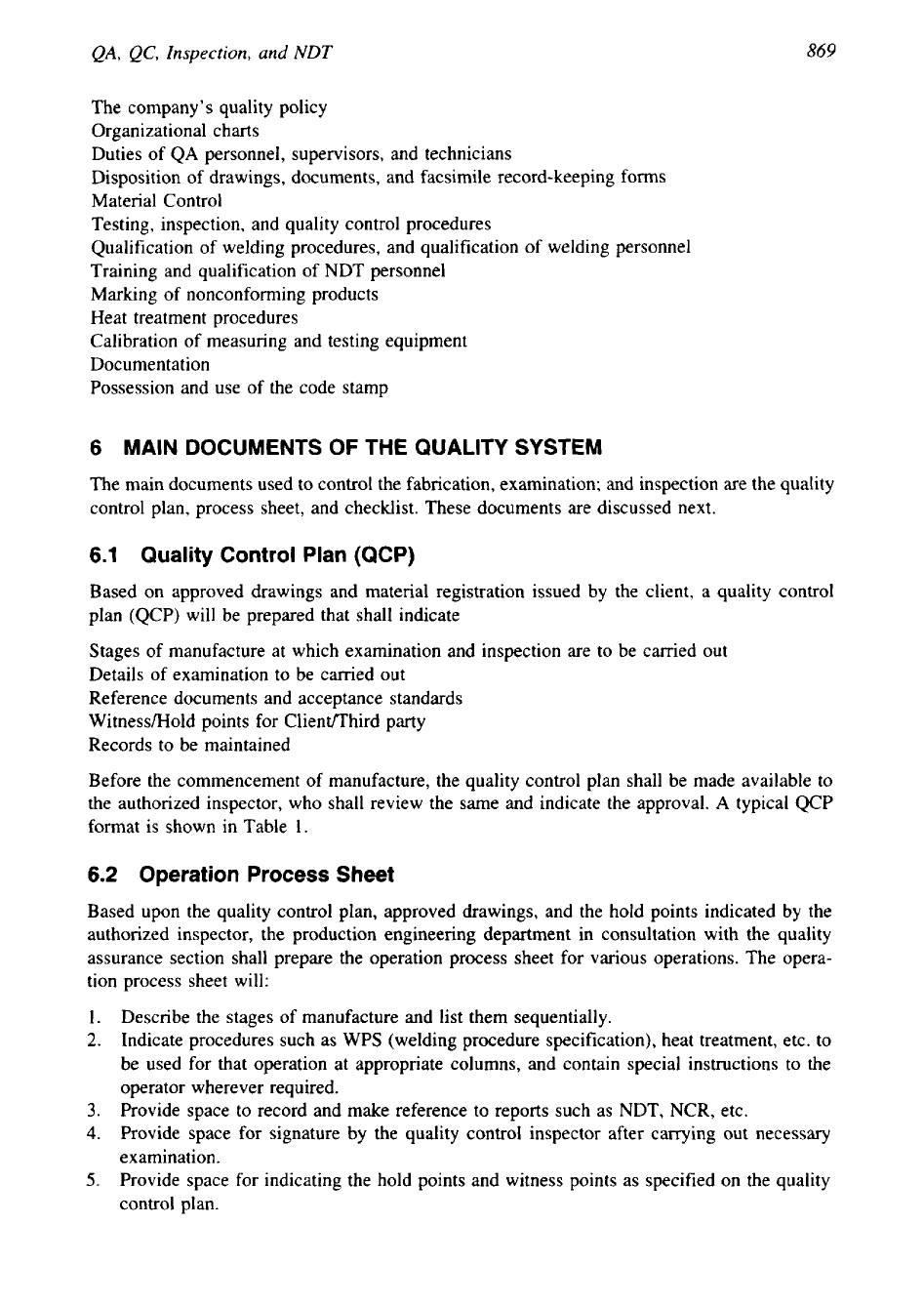
QA,
QC,
Inspection,
and
NDT
869
The company's quality policy
Organizational charts
Duties of QA personnel, supervisors, and technicians
Disposition of drawings, documents, and facsimile record-keeping
forms
Material Control
Testing, inspection, and quality control procedures
Qualification of welding procedures, and qualification of welding personnel
Training and qualification of NDT personnel
Marking of nonconforming products
Heat treatment procedures
Calibration of measuring and testing equipment
Documentation
Possession and use of the code stamp
6
MAIN
DOCUMENTS
OF
THE QUALITY SYSTEM
The main documents used to control the fabrication, examination; and inspection are the quality
control plan, process sheet, and checklist. These documents are discussed next.
6.1
Quality Control Plan (QCP)
Based on approved drawings and material registration issued by the client, a quality control
plan (QCP) will be prepared that shall indicate
Stages of manufacture at which examination and inspection are to be carried out
Details of examination to be carried out
Reference documents and acceptance standards
Witness/Hold points for Client/Third party
Records to be maintained
Before the commencement of manufacture, the quality control plan shall be made available to
the authorized inspector, who shall review the same and indicate the approval.
A
typical QCP
format is shown in Table
1.
6.2
Operation Process Sheet
Based upon the quality control plan, approved drawings, and the hold points indicated by the
authorized inspector, the production engineering department in consultation with the quality
assurance section shall prepare the operation process sheet for various operations. The opera-
tion process sheet will:
1.
Describe the stages
of
manufacture and list them sequentially.
2.
Indicate procedures such as WPS (welding procedure specification), heat treatment, etc. to
be used for that operation at appropriate columns, and contain special instructions to the
operator wherever required.
3.
Provide space to record and make reference to reports such as
NDT,
NCR, etc.
4.
Provide space for signature by the quality control inspector after carrying out necessary
examination.
5.
Provide space for indicating the hold points and witness points as specified on the quality
control plan.
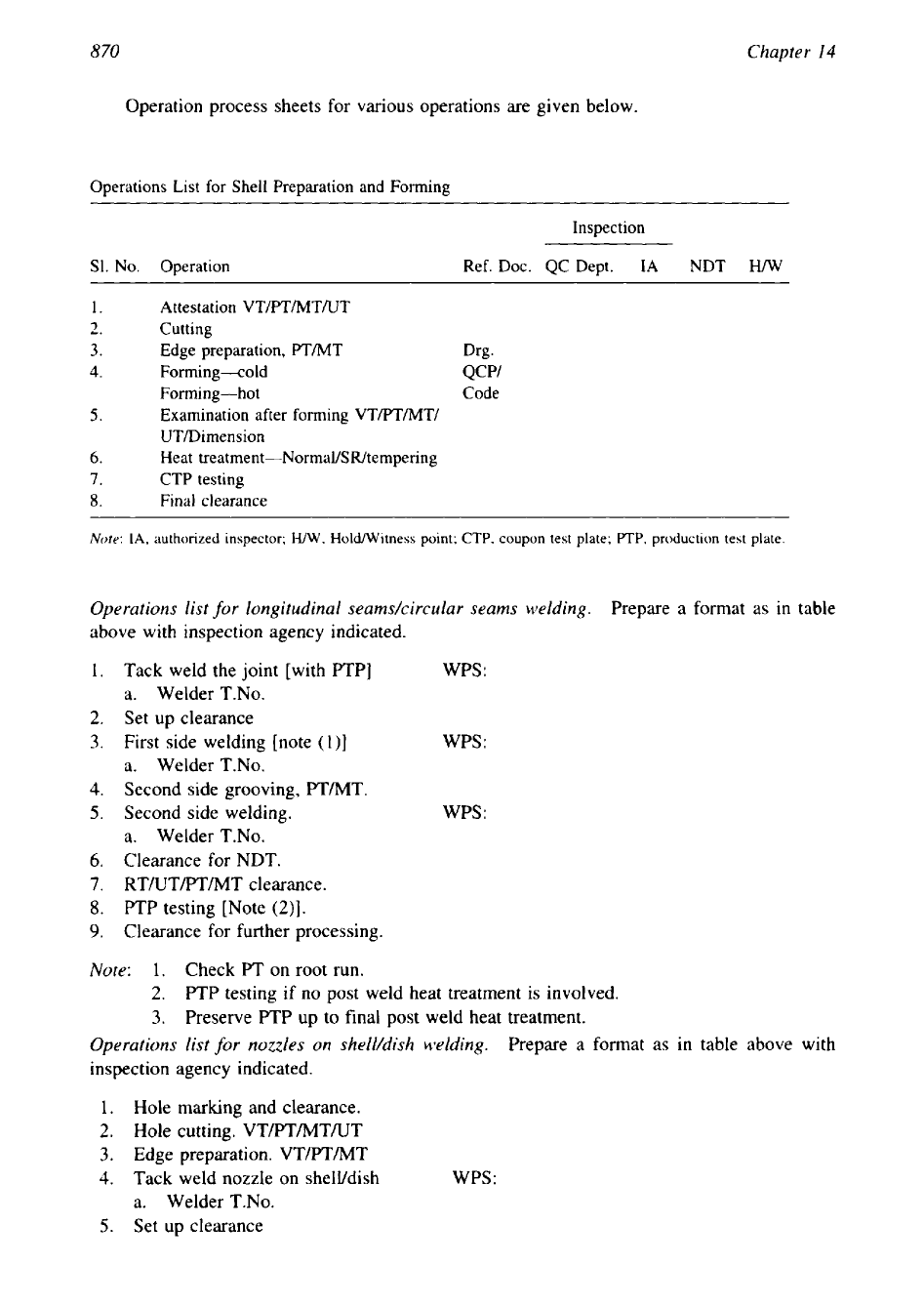
870
Chapter
14
Operation process sheets for various operations are given below.
Operations List for Shell Preparation and Forming
Inspection
S1.
No.
Operation Ref. Doc. QC Dept.
IA
NDT
WW
1.
Attestation VT/PT/MT/UT
2.
Cutting
3.
Edge preparation,
PTNT
Drg.
4.
Forming-cold QCP/
Forming-hot Code
5.
Examination after forming VT/PT/MT/
UTDimension
6.
Heat
treatment-NormaYSWtempering
7.
CTP testing
8.
Final clearance
Note:
IA,
authorized inspector;
W,
HolWitness point;
CTP,
coupon test plate;
PTP,
production test plate.
Operations list
for
longitudinal seamdcircular seams welding.
Prepare a format as
in
table
above with inspection agency indicated.
1.
Tack weld the joint [with PTP]
WPS:
a. Welder T.No.
2.
Set up clearance
3.
First side welding [note
(l)]
WPS:
a. Welder T.No.
4.
Second side grooving, PT/MT.
5.
Second side welding. WPS:
a. Welder T.No.
6.
Clearance for NDT.
7.
RT/UT/PT/MT clearance.
8.
PTP testing [Note
(2)].
9.
Clearance for further processing.
Note:
1.
Check PT on root run.
2.
PTP testing if no post weld heat treatment is involved.
3.
Preserve PTP up to final post weld heat treatment.
Operations list
for
nozzles on
shell/dish
welding.
Prepare
a
format as in table above with
inspection agency indicated.
1.
Hole marking and clearance.
2.
Hole cutting. VT/PT/MT/UT
3.
Edge preparation. VT/PT/MT
4.
Tack weld nozzle
on
shelVdish WPS:
a. Welder T.No.
5.
Set
up
clearance

871
QA,
QC,
Inspection, and
NDT
6.
First side welding-Note (1)
WPS:
a. Welder T.No.
Rev:
7. Second side gouging, PTMT
8.
Second side welding
WPS:
a. Welder T.No.
Rev:
9.
Dress up of weldment
10. Visual examination
1 1. UT/PT/MT/Marking clearance
12. Air Leak test of reinforcement pads
(Pressure.
. .
Kg/Sq.cm.)
13. Clearance for further process
Note:
1. Check PT on root run.
Operation list
for
drilling
of
tubesheets.
agency indicated.
1.
Holes marking
2.
Drilling
Pilot
I
dia.
Pilot
I1
dia.
Pilot
111
dia.
Finish reamer
Prepare a format as in table above with inspection
3.
Expansion annular rings grooving, and chamfering (if applicable)
4. Pass partition grooving
5.
Drilling and tapping for tie rods, pulling eyes, and lugs
6.
Obtain clearance
Operation list
for
fixed tubesheet heat
exchanger
assembly.
Prepare a format as
in
table
above with inspection agency indicated.
1.
Set one tubesheet on the fixture.
2.
Assemble the baffles, tie rods and spacer tubes or sealing strips.
3.
Insert the tubes.
4.
Tighten the nuts, lock nuts, and weld.
5.
Set and weld the impingement plate.
Welder
T.No.
6.
Set and weld the slidinghealing strips, if
any.
Welder T.
No.
7.
Check tube bundle with ring gauge.
8.
Check shell inside with push through gauge.
9.
Obtain clearance for tube bundle insertion.
10.
Insert the tube bundle into shell.
11.
Set the second tube sheet and draw the tubes through
12.
Weld the second tubesheet with shell.
13.
Level the tubesheet side and obtain clearance.
14.
Complete the tube-to-tubesheet root run welding and inspect by
PT.
Welder T.No.
15.
Complete lighvstrength expansion and obtain clearance.
16.
Trim the excess portion in tubes and obtain clearance.
17.
Machine the gasket seating surface, if distortion is noticed.
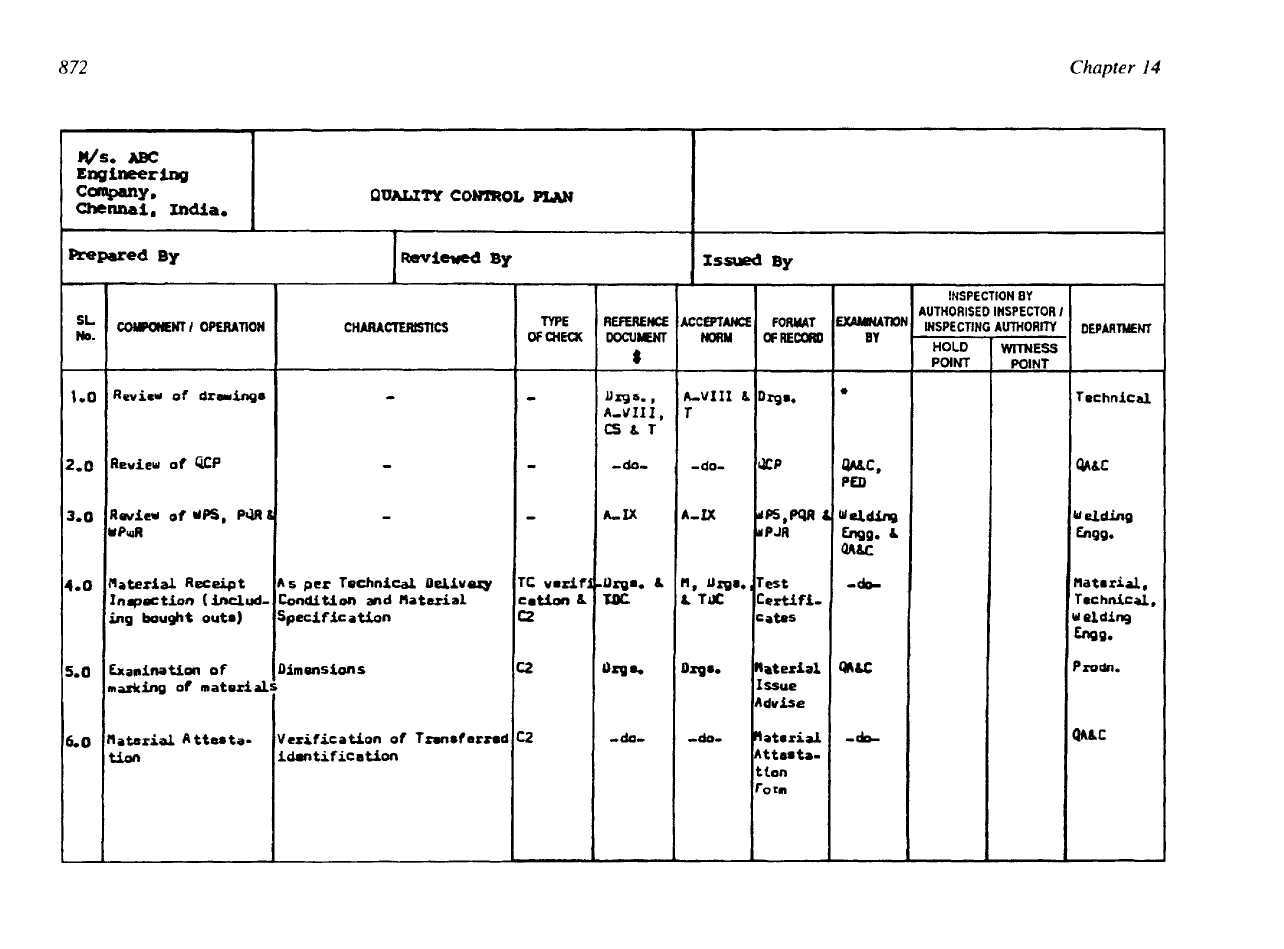
8
72
Chapter
I4
coIIp0NE)cII
OPERATION
Review
of
drePrbgs
Review
of
WP
Raterid
Receipt
Inspa:
tion
(
fnclud-
inp
bought
out.)
Exanination
of
ndhg
of
material
TYPE
CHARACrrWSnCS
OF
CHEEK
...
s per
Technical Delivory
bnditlon
and
Material
peci
f
ic
ation
imensions
erificauon
of
Tmrf
erred
den
ti
f
ice
tion
I
1
fNSPfCTlON
BY
AUTHORISED
INSPECTOR
I
kCCEPTM
FORMAT
~SPECTING
A~ORI~
NORM
OFREOORO
HOLD
WITNESS
POlM
POINT
i
~
Technical
WC
velding
%iQ*
Mat
e
rid,
Tec
hdcal
,
d
ekding
h!b
PXOdn.
2AAhC
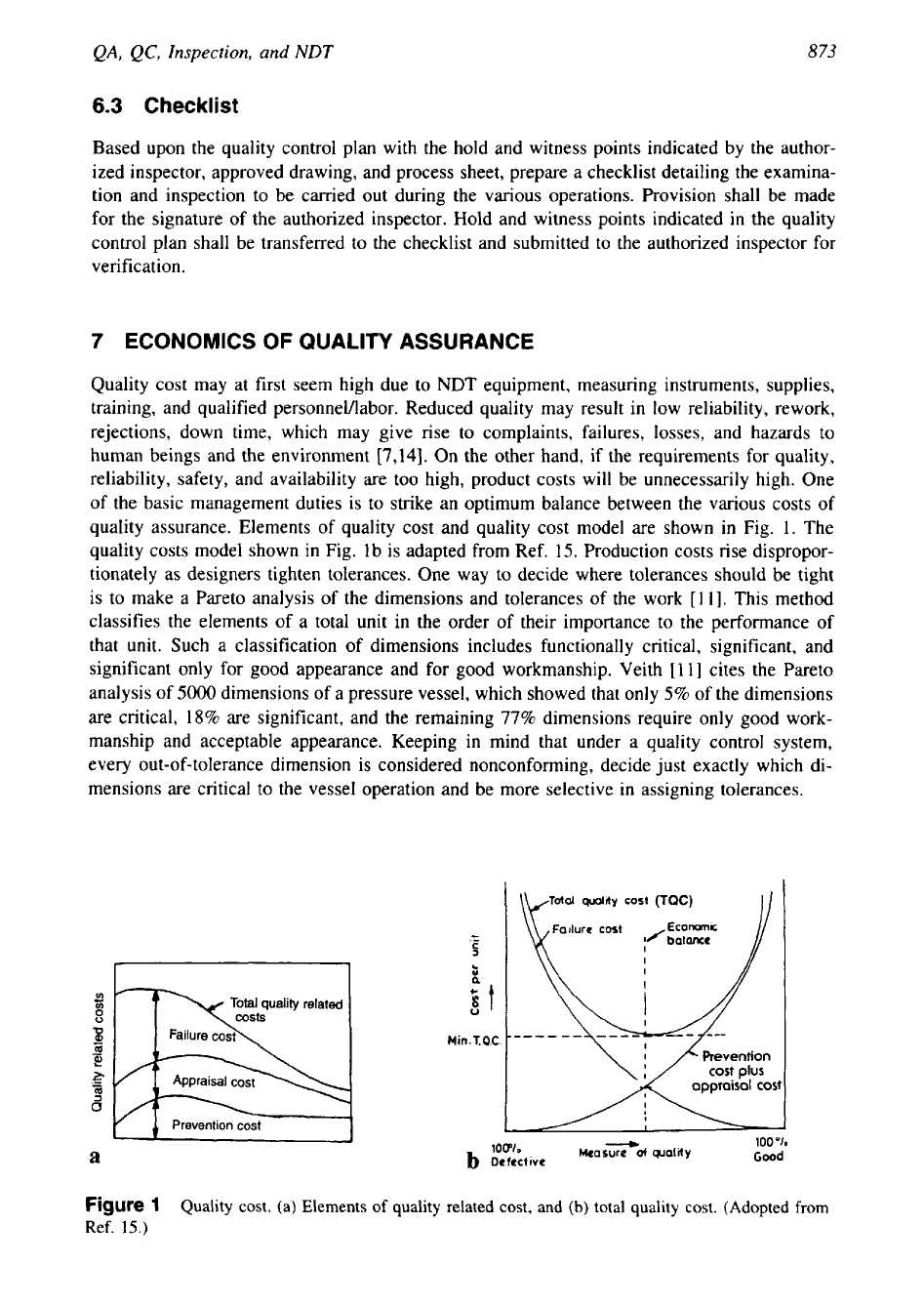
QA,
QC,
Inspection,
and
NDT
873
6.3
Checklist
Based upon the quality control plan with the hold and witness points indicated by the author-
ized inspector, approved drawing, and process sheet, prepare a checklist detailing the examina-
tion and inspection to be carried out during the various operations. Provision shall be made
for the signature of the authorized inspector. Hold and witness points indicated in the quality
control plan shall be transferred to the checklist and submitted to the authorized inspector for
verification.
7
ECONOMICS
OF
QUALITY ASSURANCE
Quality cost may at first seem high due to
NDT
equipment, measuring instruments, supplies,
training, and qualified personneMabor. Reduced quality may result in low reliability, rework,
rejections, down time, which may give rise to complaints, failures, losses, and hazards to
human beings and the environment [7,14]. On the other hand, if the requirements for quality,
reliability, safety, and availability are too high, product costs will be unnecessarily high. One
of the basic management duties is to strike an optimum balance between the various costs of
quality assurance. Elements of quality cost and quality cost model are shown in Fig.
1.
The
quality costs model shown
in
Fig. lb is adapted from Ref. 15. Production costs rise dispropor-
tionately as designers tighten tolerances. One way to decide where tolerances should be tight
is to make a Pareto analysis of the dimensions and tolerances of the work
[
111.
This method
classifies the elements of a total unit in the order of their importance to the performance of
that unit. Such a classification of dimensions includes functionally critical, significant, and
significant only for good appearance and for good workmanship. Veith
[
1
I]
cites the Pareto
analysis
of
5000
dimensions of a pressure vessel, which showed that only
5%
of the dimensions
are critical,
18%
are significant, and the remaining 77% dimensions require only good work-
manship and acceptable appearance. Keeping in mind that under a quality control system,
every out-of-tolerance dimension is considered nonconforming, decide just exactly which di-
mensions are critical to the vessel operation and be more selective in assigning tolerances.
Total
quality
related
Prevention
cost
Measure
of
quality
Good
a
J
b
Defective
lOP/O
4
100
Vo
Figure
1
Quality cost. (a) Elements of quality related cost, and
(b)
total quality cost. (Adopted from
Ref.
15.)
